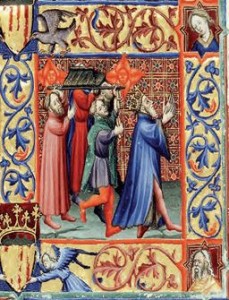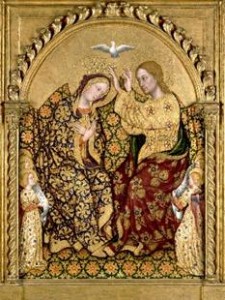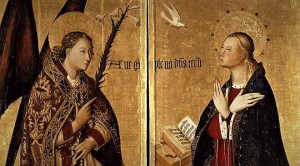The “International Gothic Style” of paintings reached great diffusion in Valencia during the change of 14th c. and 15th c; art, beauty and luxury were not only an exclusive privilege of the noble estate. The new emerging commercial bourgeoisie class, they expressed sumptuary will through various artistic forms on that time (jewellery, miniatures, altarpieces, devotional tables, illuminated books, small decorated boxes, etc.) was a courtier and yet bourgeois art. This attitude was extended to almost all social statements; it favoured the acceptance and adoption of new artistic forms that triumphed in Europe and they were well known as “International Gothic Style”.
 The city of Valencia, after the crisis of 1380 (due to continuing poor harvests and consequence increasing prices, that entailed the migration of peasants to the city; traders withdrew the capital of commerce and craft production disinvestment in gone into the unemployment and ruin; bankers in bankrupt damaged the exchequer causing economical political and commercial instability) was in a moment of constructive splendour and artistic development. This occurred especially during
The city of Valencia, after the crisis of 1380 (due to continuing poor harvests and consequence increasing prices, that entailed the migration of peasants to the city; traders withdrew the capital of commerce and craft production disinvestment in gone into the unemployment and ruin; bankers in bankrupt damaged the exchequer causing economical political and commercial instability) was in a moment of constructive splendour and artistic development. This occurred especially during the last decades of 14th c: In 1386 while the Serranos Gate was built, the Chapter of the Cathedral boosted the renewal of The Seu (cathedral) and King Juan I fixed residence in the city and with him the Court and Church Hierarchies. In 1394 Don Pedro Martinez de Luna, bishop of Valencia was named Pope in Avignon and two years later, in 1396, after the death of King John I, Martin I was crowed as the new king, summoning Courts in Valencia City. The new monarch, decided to promote culture, arts and literature, founding the Charterhouse of Valldecrist, as a centre for cultural dissemination under the direct patronage of the crown.
the last decades of 14th c: In 1386 while the Serranos Gate was built, the Chapter of the Cathedral boosted the renewal of The Seu (cathedral) and King Juan I fixed residence in the city and with him the Court and Church Hierarchies. In 1394 Don Pedro Martinez de Luna, bishop of Valencia was named Pope in Avignon and two years later, in 1396, after the death of King John I, Martin I was crowed as the new king, summoning Courts in Valencia City. The new monarch, decided to promote culture, arts and literature, founding the Charterhouse of Valldecrist, as a centre for cultural dissemination under the direct patronage of the crown.
 During the first decades of the15th c., the commercial activity of Valencia was formed for a group of high permeability people, since the lack of rigid corporate rules, either, beyond its origin or wealth, could be called “merchant”. The city was open to people from other places (Castilla, Italy, Germany) and races (Jews, Mozarabic, Converts, etc.); along this growth, also commercial families, or those families related in good social or economic position (such as notaries, lawyer or exchangers, etc.) began to establish an oligarchic establishment of patrician leadership of the “honrats ciutadans”, “cavallers” and “generous”. They demanded a social identification through arts and crafts, culture, literature, etc.
During the first decades of the15th c., the commercial activity of Valencia was formed for a group of high permeability people, since the lack of rigid corporate rules, either, beyond its origin or wealth, could be called “merchant”. The city was open to people from other places (Castilla, Italy, Germany) and races (Jews, Mozarabic, Converts, etc.); along this growth, also commercial families, or those families related in good social or economic position (such as notaries, lawyer or exchangers, etc.) began to establish an oligarchic establishment of patrician leadership of the “honrats ciutadans”, “cavallers” and “generous”. They demanded a social identification through arts and crafts, culture, literature, etc.
 With that situation, Valencia became, in few years, in an expanding city, economically stable, but above all, with the aim of becoming into a great metropolis of the Aragon Crown and therefore an important place all over the Mediterranean Countries. The Consell of the city, Council of the Cathedral, Parish Churches Gentlemen, Middle-Class people, Urban Patrician and King Martin himself they looked for new artistic references with which identify, and everyone wanted to use the visual arts as a sign of strength, wealth and social distinction.
With that situation, Valencia became, in few years, in an expanding city, economically stable, but above all, with the aim of becoming into a great metropolis of the Aragon Crown and therefore an important place all over the Mediterranean Countries. The Consell of the city, Council of the Cathedral, Parish Churches Gentlemen, Middle-Class people, Urban Patrician and King Martin himself they looked for new artistic references with which identify, and everyone wanted to use the visual arts as a sign of strength, wealth and social distinction.
 This situation favoured the city that became into an artistic focus of international projection, where agreements for first level arts and crafts works, according to the taste of the time, were made. Proof of this are the numerous notarial agreements, (preserved and published) where the names and origin of the artists appear, with details of the work and the conditions of these. They were local and foreign artist, who came from Aragon, Catalonia and the Spanish Kingdoms; but also from Italy, Germany and the Netherlands. They created a particular and peculiar style around those years: The “International Gothic Style”; which was settled here with success by the lack of a previous pictorial tradition (past Arabic times without Christian art) and the unique characteristics of the City of Valencia as “Cap i Casal del Regne“.
This situation favoured the city that became into an artistic focus of international projection, where agreements for first level arts and crafts works, according to the taste of the time, were made. Proof of this are the numerous notarial agreements, (preserved and published) where the names and origin of the artists appear, with details of the work and the conditions of these. They were local and foreign artist, who came from Aragon, Catalonia and the Spanish Kingdoms; but also from Italy, Germany and the Netherlands. They created a particular and peculiar style around those years: The “International Gothic Style”; which was settled here with success by the lack of a previous pictorial tradition (past Arabic times without Christian art) and the unique characteristics of the City of Valencia as “Cap i Casal del Regne“.
 The work of the painters in Valencia were considered more of art and artisans work, they were organized into corporations or “guilds” and subject to common laws based on the own benefit and the benefit of the city. The work at the “workshop” was the meant of self-subsistence of these artisans, the centre of working and life; formed by the master, officers and trainees. Established as work, learning place of artists, and meeting place for new trends and influences that crystallized in the “International” style.
The work of the painters in Valencia were considered more of art and artisans work, they were organized into corporations or “guilds” and subject to common laws based on the own benefit and the benefit of the city. The work at the “workshop” was the meant of self-subsistence of these artisans, the centre of working and life; formed by the master, officers and trainees. Established as work, learning place of artists, and meeting place for new trends and influences that crystallized in the “International” style.
 Something characteristic of the Valencian paintings of this period is the wealth and magnificence of the works, contributed the commercial strength of the city and its customers, who liked the abundance of gold like miniature drawings but in big size. We can see in their works the merger of three aesthetic trends: On the one
Something characteristic of the Valencian paintings of this period is the wealth and magnificence of the works, contributed the commercial strength of the city and its customers, who liked the abundance of gold like miniature drawings but in big size. We can see in their works the merger of three aesthetic trends: On the one  side the influence of the Franco-Burgundian miniaturist school with its bright colourful, the characters, the delicacy models, and sumptuousness in tissues and ornaments. On the other side, the German influence with its rude realism, darker colours, and dramatic compositions, with twisted and cartoonish characters. In addition, the third influence comes from Italy by architectural and landscape perspectives, funded with combine use of gold and clear colours and the idealization of the figures.
side the influence of the Franco-Burgundian miniaturist school with its bright colourful, the characters, the delicacy models, and sumptuousness in tissues and ornaments. On the other side, the German influence with its rude realism, darker colours, and dramatic compositions, with twisted and cartoonish characters. In addition, the third influence comes from Italy by architectural and landscape perspectives, funded with combine use of gold and clear colours and the idealization of the figures.
 Given the conditions, Valencia became one important capital of the International Gothic Style, the arrival of foreign artists like Marçal de Sax and Gherardo Starninna, representing two different aesthetic worlds; liked to the presence of another local master like Pere Nicolau, and the arrival of Lorenzo Zaragoza from Aragon, completing the artistic Starting Scene. With them the First Generation, which marked the aesthetic guidelines to follow, was establ
Given the conditions, Valencia became one important capital of the International Gothic Style, the arrival of foreign artists like Marçal de Sax and Gherardo Starninna, representing two different aesthetic worlds; liked to the presence of another local master like Pere Nicolau, and the arrival of Lorenzo Zaragoza from Aragon, completing the artistic Starting Scene. With them the First Generation, which marked the aesthetic guidelines to follow, was establ ished. After these “masters” appeared Antoni Peris, Gonçal Peris, Miquel Alcanyiç, Bacó Jaume, Joan Reixach, Luis Dalmau, constituting the Second Generation, with which that style reached its climax. On the other hand, other painters were establish in Valencia during this time, as Joan Sarebolleda, Guillem Casas, Francesc Comes, Bernart Vilaur, etc., but his style has nothing to see with the “International Gothic Style”.
ished. After these “masters” appeared Antoni Peris, Gonçal Peris, Miquel Alcanyiç, Bacó Jaume, Joan Reixach, Luis Dalmau, constituting the Second Generation, with which that style reached its climax. On the other hand, other painters were establish in Valencia during this time, as Joan Sarebolleda, Guillem Casas, Francesc Comes, Bernart Vilaur, etc., but his style has nothing to see with the “International Gothic Style”.
 The importance of the Valencia paintings not only resided in the quality of the artists and their works, was the ability to spread this style to other places in a short time, like Catalonia, Murcia, Castilla, Mallorca where just residing Miquel Alcanyiç, Aragon with Gonçal Peris, etc. However, from 1425-30 the International Gothic Style languished with the emergence of a new aesthetic taste, the “Flemish Style”, that already triumphed in Europe.
The importance of the Valencia paintings not only resided in the quality of the artists and their works, was the ability to spread this style to other places in a short time, like Catalonia, Murcia, Castilla, Mallorca where just residing Miquel Alcanyiç, Aragon with Gonçal Peris, etc. However, from 1425-30 the International Gothic Style languished with the emergence of a new aesthetic taste, the “Flemish Style”, that already triumphed in Europe.
To discover this style of paintings we recommend to visit The Fine Arts Museum of Saint Pius V of Valencia, that contains a very interesting collection of altarpieces.
© FernandoC.
 |
 |
 |
|---|


